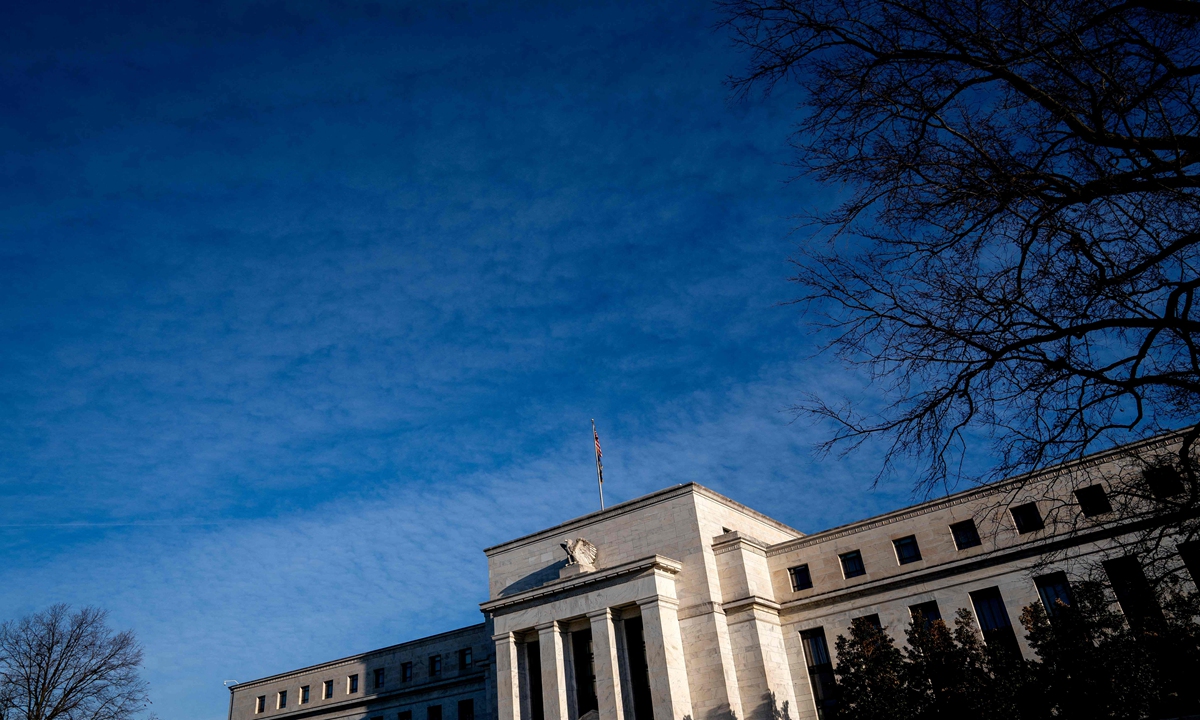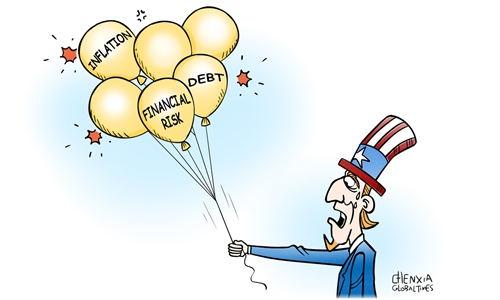
A view of the US Federal Reserve in Washington DC Photo: VCG
Global investors are becoming optimistic that the US Federal Reserve has leaned toward maintaining the current interest rates intact for a third time at the FOMC's upcoming meeting on December 12-13. And, the US central bank is likely to keep the interest rates at current levels in the coming six months before eventually reducing the benchmark rates sometime around June next year.The US Federal Reserve is now navigating a difficult balancing act by fine-tuning the rates to tame inflation without triggering a broad US recession. Economists are worried that rising interest rates will ratchet up borrowing costs for companies and consumers, restraining economic activity by weighing on investment and broad consumption. Up to now, the US labor market has been quite resilient with a low jobless rate.
The Fed has raised federal funds rates 11 times since March 2022 for a total of 5.25 percentage points. Coming from the near-zero level early last year, the Fed has taken the benchmark rate to its highest level in the last 22 years. But inflation continues to run above 3 percent, meaning the labor market and economic growth may need to slow to ultimately achieve the Fed's 2 percent inflation target, which is not easy in a short run.
By many metrics, including joblessness, inflation and the stock market, the US economy seems to be running alright now. However, recent opinion polls by many US media outlets reveal that less than one quarter of American people replied that their country is headed in the right direction, which doesn't bode well for President Joe Biden who is seeking another term at the White House in November 2024.
Most economists believe the Biden administration's kneejerk or mostly reckless rush to rejuvenate the pandemic-pummeled economy by passing more than$ 2.9 trillion fiscal spending bills through Congress in 2021 and 2022 unleashed the madness, with CPI running at 9.1 percent in June 2022. There hadn't been a year with average annual inflation above 4 percent since 1991. For more than 70 percent of voting-age Americans, last year was by far the most elevated inflation of their adult lifetimes.
A recent poll on US economy found that nearly two thirds of Americans said that they were most concerned about still high prices. Even as inflation has significantly receded from its June 2022 peak, sentiment has barely shifted, with many Americans hoping that everyday prices could fall toward pre-pandemic levels, which are highly unlikely if the Fed refuses to further tighten its monetary policy. Economists say it is a fantasy for those to hope for more substantial drop in prices.
While price increases were still seen across multiple categories in the US, particularly service sector charges, some of the largest price hikes have occurred in food, gasoline and shelter, including unaffordable mortgage rates and staggering housing rents. Many middle-class Americans and low-income families, young Americans in particular, complain that their paychecks were not going as far as they used to.
Economists say that the US Fed could halt interest rate hikes for now while the officials gauge the lagged impact the previous long streak of rate hikes are expected to have on the American economy. Last month, US Fed chairman Jerome Powell acknowledged signs of cooling inflation, but said that he is not confident the FOMC has tightened monetary policy enough to keep inflation trending lower. Powell noted that the central bank knows the path will be bumpy to bring inflation down, but the organization is resolute in its commitment to its 2 percent interest rate mandate.
Nevertheless, American companies and poor households living on credit cards would loath high interest rates. Young people seeking to buy their first home and climb the property ladder face the double whammy of high house prices and high mortgage rates, creating a great affordability issue.
A large segment of American voters have valid reasons to show their uncertainty and displeasure and be skittish on the US' economic prospects. In addition to elevated prices, these people are worried about the country's fiscal health, as the US' national debt of more than $33 trillion has exceeded 120 percent of the GDP, and the debts are ticking up every second.
Rating agencies Standard & Poor's and Fitch have cut the US government's credit rating from AAA to AA+, and Moody's in October moved to lower the federal government's rating outlook from stable to negative. In the view of the rating agencies, there has been a steady deterioration in standards of governance in the US during the past 20 years on how to grow fiscal revenues and to control the national debts from endlessly expanding.
For many years, the US presidents from both political parties only agree to take half-measures to bring down swollen federal debts, which could sow the seeds for financial volatilities or even another financial crisis later. As a result, a majority of Americans, recently polled, said that the current generation is actually stealing from the next one, who will most likely have a lower standard of living. That also explains why a growing number of younger American voters polled tend to keep a distance from the Biden administration's economic policies, because they are feeling increasingly disgruntled about their bleak future.
The author is an editor with the Global Times. bizopinion@globaltimes.com.cn



